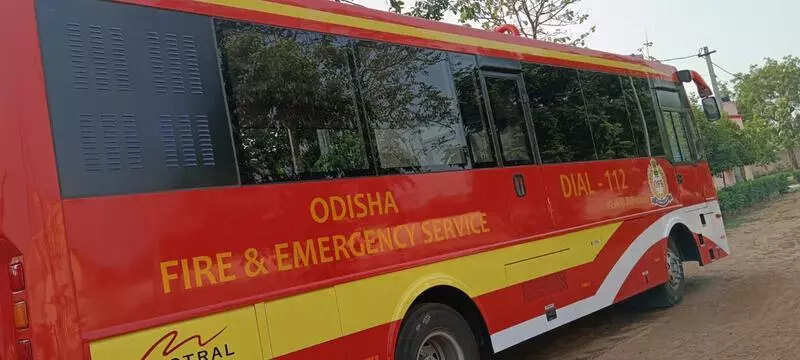Odisha enhances disaster response with mobile command vehicles

Bhubaneswar: Giving a significant boost to its emergency response infrastructure, the govt has procured two specialized vehicles, described as “offices on wheels”, that are designed to serve as mobile command centres during major incidents such as large-scale fires, train accidents, and natural disasters.
The state fire and emergency service directorate has received two advanced mobile command vehicles (MCVs) — one designated for coastal regions and another for western areas. These units enable incident commanders to manage rescue operations directly from disaster locations, enhancing response efficiency.
Official sources indicated these vehicles were acquired following the Bahanaga train incident that required extensive rescue and restoration work. The tragedy resulted in 296 passenger fatalities and over 1,000 injuries on June 2, 2023.
The MCVs feature cutting-edge technology, including video conferencing systems, sophisticated communication equipment and real-time data processing units. These capabilities ensure continuous communication with various agencies while facilitating decisions based on live ground updates.
These command vehicles are equipped with modern communication devices, satellite phones, internet connectivity, computers and printers. They feature display screens connected to CCTV cameras and drones for real-time situation monitoring.
The vehicles incorporate dedicated workspaces for senior officers and technical specialists to assess situations and develop response strategies. “In emergency situations, every minute counts. These MCVs eliminate the need for setting up temporary command posts and ensure that our leadership team can begin coordinating response efforts immediately upon arrival,” director general (fire and emergency service) Sudhansu Sarangi told TOI.
Sarangi said, “It is essentially a ‘mobile or running office’ equipped with all facilities for effective incident leadership. One can hold VC with state and national capitals. The incident commanders can coordinate with the rescue workers on the ground, and with authorities at different levels.”
Sources indicated that similar vehicles are utilised by the Army, NSG and various state police forces for coordinating major operations. “During extensive rescue operations, officers typically remain on-site for 48 to 72 hours. The MCVs provide essential office space with modern communication facilities, rest areas and toilets. For example, in Rath Yatra this MCV can become the command centre for better coordination among various govt stakeholders for smooth conduct of the crowded festival,” Sarangi said.
Officials stated that during floods and cyclones, these vehicles can be positioned near disaster locations to assist incident commanders in coordinating rescue and restoration activities. Officials said the MCVs can serve as emergency offices during visits by the prime minister, chief minister or other ministers to incident sites, facilitating briefings about rescue operation progress. Earlier, crowded environments created significant communication challenges, with limited facilities for rest or personal needs.
The state fire and emergency service directorate has received two advanced mobile command vehicles (MCVs) — one designated for coastal regions and another for western areas. These units enable incident commanders to manage rescue operations directly from disaster locations, enhancing response efficiency.
Official sources indicated these vehicles were acquired following the Bahanaga train incident that required extensive rescue and restoration work. The tragedy resulted in 296 passenger fatalities and over 1,000 injuries on June 2, 2023.
The MCVs feature cutting-edge technology, including video conferencing systems, sophisticated communication equipment and real-time data processing units. These capabilities ensure continuous communication with various agencies while facilitating decisions based on live ground updates.
These command vehicles are equipped with modern communication devices, satellite phones, internet connectivity, computers and printers. They feature display screens connected to CCTV cameras and drones for real-time situation monitoring.
The vehicles incorporate dedicated workspaces for senior officers and technical specialists to assess situations and develop response strategies. “In emergency situations, every minute counts. These MCVs eliminate the need for setting up temporary command posts and ensure that our leadership team can begin coordinating response efforts immediately upon arrival,” director general (fire and emergency service) Sudhansu Sarangi told TOI.
Sarangi said, “It is essentially a ‘mobile or running office’ equipped with all facilities for effective incident leadership. One can hold VC with state and national capitals. The incident commanders can coordinate with the rescue workers on the ground, and with authorities at different levels.”
Sources indicated that similar vehicles are utilised by the Army, NSG and various state police forces for coordinating major operations. “During extensive rescue operations, officers typically remain on-site for 48 to 72 hours. The MCVs provide essential office space with modern communication facilities, rest areas and toilets. For example, in Rath Yatra this MCV can become the command centre for better coordination among various govt stakeholders for smooth conduct of the crowded festival,” Sarangi said.
Officials stated that during floods and cyclones, these vehicles can be positioned near disaster locations to assist incident commanders in coordinating rescue and restoration activities. Officials said the MCVs can serve as emergency offices during visits by the prime minister, chief minister or other ministers to incident sites, facilitating briefings about rescue operation progress. Earlier, crowded environments created significant communication challenges, with limited facilities for rest or personal needs.
















